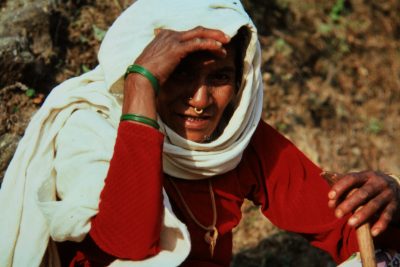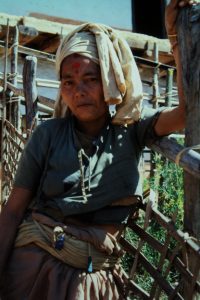Women’s Art and Other Work in Nepal’s Hill Country
Part II

Chait Purnima morning. The essentials for our day’s work are assembled before guest workers arrive on our doormats. A five gallon pot of kodo (millet beer) is fermenting inside the house; we also have six bottles of raxsi, the clear gin-like drink distilled from fermented kodo. Kodo is generally not for sale but produced (in every home) for family consumption. (A better quality is made and reserved for special occasions.) Danamaya had only a week to prepare this stock so it is coarser (and less potent). It will have to do. The bottled raxsi is not as refined a quality –sweet and aged for months in cool, sealed pots–as we would have liked. Danamaya sells me three bottles of passable quality, and we add to these another three bottles purchased from a neighbor glad to have extra cash before market day. (She can sell the rest of her stock then by the glass.)
Liquor production and sale is a pivotal item in this culture. First it’s an essential medium by which to pay workers, in this case compensation to the assembly of women who will fashion my necklace. Second, Limbu alcohol facilitates warm memories of times spent together, occasions like this Purnima. Third, sale of liquor in the market is an important source of cash, the foundation of women’s independent economic experience. Exclusive brewers of this highly popular product, these women and most other hill people refine their brewing skills and compete for the cash rewards.
From a young age Limbu women own jewelry. Their attachment to jewelry derives though their family membership and their own contribution to the household economy. Her nose-ring is a girl’s first acquisition; she may be hardly ten when she has her first band of gold. Year by year, as she grows, twirls of gold leaf purchased from her own earnings are added to it. From childhood a girl is allowed to keep what she earns from the goats she’s given to care for. Thus, by the age of 18, a young Limbu woman may be able to purchase her own gold earrings.
The naugiri is a different matter. It is acquired with womanhood and marriage. A gift from her family at the time of her betrothal.
Five women from our household begin the day’s work on my naugiri. Danamaya takes charge at the outset by anchoring a nylon rope to her body. (She has clearly done this many times.) Rubbing the loosened rope ends in her palms, she separates it into individual strands. Forty-five threads spread on her lap, secured at one end by a single knot between her toes. Each of us takes a single strand and arranges ourselves in a crescent becoming a human loom around Danamaya who coordinates the entire enterprise. She takes up each beaded string after we’ve filled it with tiny green glass drops; in exchange she offers us an empty one to continue our threading.
Watching Danamaya manage us I remember how efficiently she organizes our entire household. I noted this because I know Danamaya doesn’t legally reside here. True, this is her natal home, her maitighar. But like any married woman, Danamaya gave up many of her rights here when she married and moved to her husband’s family house taking her dowry with her. Here, Danamaya is a visitor with Deepa, her baby girl. In Limbu culture, it’s not uncommon for women to bring their children on a visit to the maitighar and stay for several months. Meanwhile their husbands are away as well. (They travel to India and Malaysia for work. Danamaya’s husband, for example, is serving in a Gurkha regiment in India.) I could never ascertain what she thought about this separation, or what her mother-in-law might feel about her absence. But Danamaya’s own family in Kobek is delighted to have her around and they let her run the house. (How her sisters-in-law feel about this, I never knew.)
We begin stringing the beads after our morning meal. Soon, Laxmi, Danamaya’s neighbor and friend arrives and she grasps a nylon thread like the rest of us, joining this circular-loom. She holds it taut and silently feeds the tiny glass beads, one after another. Kobek is also Laxmi’s maitighar. Unlike Danamaya however, she doesn’t intend to return to her marriage house. She remained there only until her baby was born, she explains. The infant is here and she has no intention of their returning to her husband. She doesn’t like him, she offers matter-of-factly.
A woman once married cannot normally rejoin her maitighar, so Laxmi is fortunate to be welcome here. As long as her maiti is willing to have her, a Limbu woman can divorce her husband. She may also remarry. With no apparent anxiety about her future Laxmi joins in our Chait Purnima project, beads sliding from her fingers onto a thread.
Danamaya coordinates our work, maintaining the tension in each thread until we have filled each with three inches of beads. “Enough, give it to me. Good, now take this one.”
After only an hour, Danamaya’s left hand holds only a few unadorned strings. In her right hand she grips a bunch of completed clusters of dense beads. We rush to complete the remaining threads. Then it’s time to add a gold knob. First the cluster of threads is squeezed together and fed through the opening in the red cloth ring, (what I call a washer). We sit back as Danamaya proceeds to assemble the elements: red felt ring, gold, red again. We watch the soft golden jewel shimmering down the rope and secured by another ring of red. Since the gold is pure, it’s very soft and needs careful handling. Danamaya grips the threaded strings against the red-haloed golden nugget and signals us to reassemble. We are handed a new thread to bead and we resume work, feeding the beads down the string until each of us has completed another three inches.
The seven of us have established a rhythm together and proceed independent of Danamaya’s instructions.
Another hour and I begin to discern an emerging pattern in the necklace. Sparkling, green glass, then a soft red flare against the dull luster of gold, another red flare, then sparkling glass, red again flanking the next knob of gold. Time for a rest.
Originally published on Heresies, A Feminist Publication on Art and Politics, Jan/Feb, 1978.
All images in this article are from the author.


